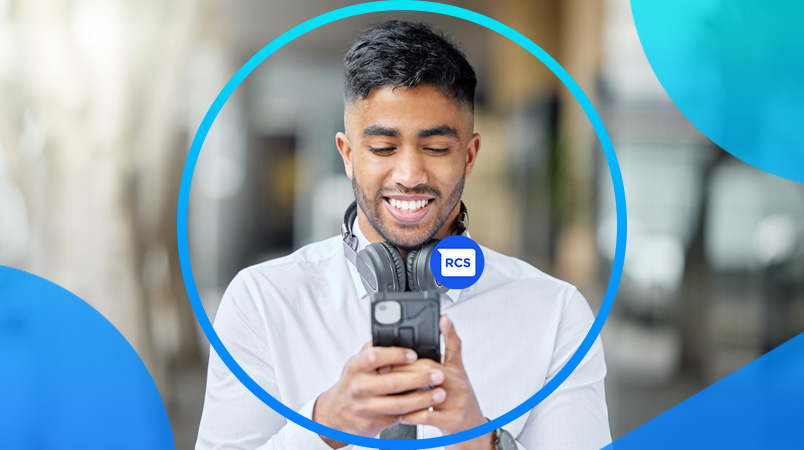How can your business use RCS for marketing? Discover how RCS messaging can help your brand share interactive content and engage with customers.
What is RCS?
Rich Communication Services (RCS) is a new messaging protocol that replaces SMS and MMS messaging, primarily on android phones. Native on android phones such as iMessage on Apple devices, RCS messaging offers many of the same features as popular messaging apps like WhatsApp, Telegram, Facebook Messenger, WeChat, and Signal.
What is chat?
Chat is a feature of the Google Messages app that provides an upgraded, rich messaging experience using RCS messaging protocol. Rather than deploying their own infrastructures, mobile carriers can use the Google platform to bring RCS messaging to their subscribers.
Chat includes typical RCS messaging features like typing indicators, read receipts, and high-resolution photos and videos like iMessage and other popular messaging platforms. However, Google has also collaborated with businesses to add powerful features to enable RCS for marketing. For example, companies can share interactive content like live updates about online orders, upcoming trips, and boarding passes.
RCS features
RCS messaging offers many exciting features. Below are three elements of RCS that will revolutionise your mobile marketing strategy.
Rich media
While SMS and MMS messaging are limited to lower resolution images, RCS messaging allows your business to share interactive content like locations, photos, videos, documents, GIFs, stickers, carousels, and much more.
The maximum file size for MMS messages is only 3.5 MB, which is why images shared via MMS are often blurry or pixelated, especially videos and GIFs. However, RCS messaging enables users to send files up to 105 MB in size, opening up many more possibilities for brands to share engaging visual content with their customers.
Suggested responses and actions
With RCS messaging, your business can create suggested responses and actions for your customers, making it easier to take the next step in the customer journey. This feature enables customers to book appointments, complete transactions, and see real-time delivery updates, all without leaving the app.
For example, customers that message your brand can select the “schedule now” button and pick a date and time to set up an appointment. You can also use RCS messaging to confirm appointments by offering a “yes” or “reschedule” suggested response for customers.
Verified business profiles
The RCS messaging protocol requires that business users go through a verification process to eliminate fraud and spam. When your business uses RCS for marketing, customers can see that your business profile is verified, so they know that they are receiving legitimate messages.
RCS vs. SMS: what’s the difference?
SMS has long been the standard messaging protocol for text messages, but RCS messaging offers many benefits that appeal to consumers and businesses. While SMS was created for basic text messaging, RCS enhances that with the added features of modern messaging applications.
Compared to standard SMS messages, RCS sends messages over mobile data or WiFi if the recipient is also using RCS. RCS messaging can support newer communication options like video calling and data sharing in real-time by using mobile data.
RCS is native on most android devices and can be used once it’s activated. To use RCS messaging, download Google’s Messages app or another compatible app. However, some carriers automatically register and activate RCS on Samsung devices.
How will RCS change digital communications?
RCS improves basic texting by adding features like rich media, group chats, and more. Using RCS for marketing can help brands engage in meaningful conversations with customers and boost engagement. Your business can use RCS messaging to keep customers informed and nurture long-lasting relationships, driving sales and customer loyalty.
But adopting RCS messaging has been a slow process. Although Google has led the RCS rollout by collaborating with mobile carriers and Android smartphone companies, RCS is not yet a universal messaging protocol. Since 70% of smartphones use Android and can’t use iMessage, implementing RCS as a seamless messaging protocol will allow brands to reach more users with a rich experience.
Integrate your conversational channels with CM.com’s CPaaS
RCS messaging can bring the best features of popular messaging platforms to every phone. From rich media to verified business profiles, RCS for marketing will allow you to engage with customers like never before.
CM.com’s Mobile Marketing Cloud is the only omnichannel customer engagement solution that includes mobile messaging channels like SMS, RCS, and WhatsApp, delivering a superior customer experience to increase engagement and drive conversion.
In addition, our unified Communications Platform-as-a-Service (CPaaS) provides your customers with on-the-go access to your business via all their favourite conversational channels via our Business Messaging API.




